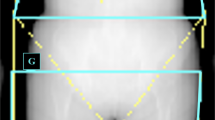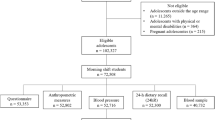Abstract
Objective:
To define fatty acid and macronutrient intakes in a rural Chinese preschool population, and relate these intakes to anthropometric indices.
Design:
Cross-sectional survey of anthropometry and diet (three 24-h recalls). National Centers for Health Statistics/World Health Organization growth reference charts were used to determine the prevalence of malnutrition (z-scores less than −2 standard deviation (s.d.) below the mean): height-for-age (stunted), weight-for-age (underweight), weight-for-height (wasted) and mid-upper-arm-circumference-for-age (low fat/muscle).
Subjects and setting:
A total of 196 children aged 1–5 years old were volunteered by their families to participate in the survey, located in Heqing County, Yunnan Province, China.
Results:
The respective prevalence of stunting, underweight, wasting and low fat/muscle was: 38, 21, 2 and 8%. Daily intakes of linoleic acid (LA; 18:2n-6), α-linolenic acid (LNA; 18:3n-3), arachidonic acid (AA; 20:4n-6) and docosahexaenoic acid (DHA; 22:6n-3), averaged for all children, were 2 100±1200, 300±250, 55±35 and 30±140 mg/day, respectively. As percent of total fat intake, LA contributed 11.9%, LNA 1.8%, AA 0.3% and DHA 0.2%. Height-for-age and weight-for-age z-scores were negatively correlated with g/kg/day intake of LA and AA (P<0.05). Weight-for-height z-score was negatively correlated with AA g/kg/day intake (P<0.05).
Conclusions:
This study provided polyunsaturated fatty acids (PUFA) intakes in rural preschool children in a developing country. The associations of PUFA intake with early childhood growth suggest that growth in preschool-aged children could be significantly and specifically related to n-6 fatty acid intakes.
Sponsorship:
ECOFund and NSERC.
This is a preview of subscription content, access via your institution
Access options
Subscribe to this journal
Receive 12 print issues and online access
$259.00 per year
only $21.58 per issue
Buy this article
- Purchase on Springer Link
- Instant access to full article PDF
Prices may be subject to local taxes which are calculated during checkout
Similar content being viewed by others
References
Agostoni C, Riva E, Trojan S, Bellu R, Giovannini M (1995). Docosahexaenoic acid status and developmental quotient of healthy term infants. Lancet 346, 638.
Beaton G, Kelly A, Kevany J, Martorell R, Mason J (1990). Appropriate uses of anthropometric indices in children. ASS/SCN State of the art series nutrition policy discussion paper No. 7. World Health Organization: Geneva.
Beaton GH, Milner J, McGuire V, Feather TE, Little JA (1983). Source of variance in 24-h dietary recall data: implications for nutrition study design and interpretation. Carbohydrate sources, vitamins, and minerals. Am J Clin Nutr 37, 986–995.
Birch EE, Garfield S, Hoffman DR, Uauy R, Birch DG (2000). A randomized controlled trial of early dietary supply of long-chain polyunsaturated fatty acids and mental development in term infants. Dev Med Child Neurol 42, 174–181.
Birch EE, Hoffman DR, Castaneda YS, Fawcett SL, Birch DG, Uauy RD (2002). A randomized controlled trial of long-chain polyunsaturated fatty acid supplementation of formula in term infants after weaning at 6 wk of age. Am J Clin Nutr 75, 570–580.
Biro G, Hushof KFAM, Ovesen L, Amorim Cruz JA (2002). Selection of methodology to assess food intake. Eur J Clin Nutr 56, S25–S32.
Chinese Nutrition Society (2005). RNIs of energy and protein and percentage of energy from fat. DRIs:www.cnsoc.org.
Chunming C (2000). Fat intake and nutritional status of children in China. Am J Clin Nutr 72 (Suppl), S1368–S1372.
Clandinin MT, Chappell JE, Leong S, Heim T, Swyer PR, Chance GW (1980). Extrauterine fatty acid accretion in infant brain: implications for fatty acid requirements. Early Hum Dev 4, 131–138.
Clandinin MT, Van Aerde JE, Merkel KL, Harris CL, Springer MA, Hansen JW et al. (2005). Growth and development of preterm infants fed infant formulas containing docosahexaenoic acid and arachidonic acid. J Pediatr 146, 461–468.
Cogill B (2003). Anthropometric Indicators Measurement Guide. Food and Nutrition Technical Assistance Project, Academy for Educational Development: Washington, DC.
Cook HW, Clarke JT, Spence MW (1983). Concerted stimulation and inhibition of desaturation, chain elongation, and esterification of essential fatty acids by cultured neuroblastoma cells. J Biol Chem 258, 7586–7591.
Crawford MA, Golfetto I, Ghebremeskel K, Min Y, Moodley T, Poston L et al. (2003). The potential role for arachidonic and docosahexanoic acids in protection against some central nervous system injuries in preterm infants. Lipids 38, 303–315.
Ferguson EL, Gibson RS, Opare-Obisaw C (1994). The relative validity of the repeated 24 h recall for estimating energy and selected nutrient intakes of rural Ghanaian children. Eur J Clin Nutr 48, 241–252.
Food and Nutrition Board and the Institutes of Medicine (2002). Dietary Reference Intakes for Energy, Carbohydrate, Fiber, Fat, Fatty Acids, Cholesterol, Protein, and Amino Acids (Macronutrients). National Academies Press: Washington, DC.
Gibson RS, Ferguson EL (1999). An Interactive 24-h Recall for Assessing the Adequacy of Iron and Zinc Intakes in Developing Countries. International Life Sciences Institute: Washington, DC.
Giovanni M, Riva E, Agostoni C (1998). The role of polyunsaturated fatty acids during the first two years of life. Early Hum Devel 53 (Suppl), S99–S107.
Hardy SC, Kleinman RE (1994). Fat and cholesterol in the diet of infants and young children: implications for growth development and long term health. J Pediatr 125 (Suppl), S69–S77.
Hoffman DR, Birch EE, Birch DG, Uauy R, Castaneda YS, Lapus MG et al. (2000). Impact of early dietary intake and blood lipid composition of long-chain polyunsaturated fatty acids on later visual development. J Pediatr Gastroenterol Nutr 31, 540–553.
Hoffman DR, Birch EE, Castaneda YS, Fawcett SL, Wheaton DH, Birch DG et al. (2003). Visual function in breast-fed term infants weaned to formula with or without long-chain polyunsaturates at 4–6 months: a randomized clinical trial. J Pediatr 142, 669–677.
Innis SM, Vaghri Z, King DJ (2004). N-6 Docosapentaenoic acid is not a predictor of low docosahexaenoic acid status in Canadian preschool children. Am J Clin Nutr 80, 768–773.
Jorgensen MH, Hernell O, Lund P, Lohmer G, Michaelsen KF (1996). Visual acuity and erythrocyte docosahexenoic acid status in breast-fed and formula-fed infants during the first four months of life. Lipids 339, 261–264.
Krahenbuhl JD, Schutz Y, Jequier E (1998). High fat versus high carbohydrate nutritional supplementation: a one year trial in stunted rural Gambian children. Eur J Clin Nutr 52, 213–222.
Larque E, Demmelmair H, Koletzko B (2002). Perinatal supply and metabolism of long-chain polyunsaturated fatty acids: importance for the early development of the nervous system. Ann NY Acad Sci 967, 299–310.
Lien VW, Clandinin MT (2005). Assessment of docosahexaenoic acid, arachidonic acid, vitamin A, vitamin E, and iron nutrient intakes in 4–7 year old children. Unpublished data.
Meyer BJ, Mann NJ, Lewis JL, Milligan GC, Sinclair AJ, Howe PRC (2003). Dietary intakes and food sources of omega-6 and omaga-3 polyunsaturated fatty acids. Lipids 38, 391–398.
Paeratakul S, Popkin BM, Kohlmeier L, Herz-Picciotto I, Guo X, Edwards LJ (1998). Measurement error in dietary data: implications for epidemiologic study of the diet-disease relationship. Eur J Clin Nutr 52, 722–727.
Rogers I, Emmett P (2002). Fat content of the diet among pres-school children in Britain; relationship with food and nutrient intakes. Eur J Clin Nutr 56, 252–263.
Smit EN, Muskiet FAJ, Boersma ER (2004). The possible role of essential fatty acids in the pathophysiology of malnutrition: a review. Prostag Leukotr Essent Fatty Acids 71, 241–250.
Sprecher H (1986). The metabolism of (n-3) and (n-6) fatty acids and their oxygenation by platelet cyclooxygenase and lipoxygenase. Prog Lipid Res 25, 19–28.
Stein AD, Shea S, Basch CE, Contento IR, Zybert P (1994). Assessing changes in nutrient intakes of preschool children: comparison of 24-hour dietary recall and food frequency methods. Epidemiology 5, 109–115.
Tinoco J (1982). Dietary requirements and functions of alpha-linolenic acid in animals. Prog Lipid Res 21, 1–45.
Uauy R, Hoffman DR, Mena P, Llanos A, Birch EE (2003). Term infant studies of DHA and ARA supplementation on neurodevelopment: results of randomized controlled trials. J Pediatr 143 (Suppl), S17–S25.
Walker SP, Powell CA, Grantham-McGregor SM (1990). Dietary intakes and activity levels of stunted and non-stunted children in Kingston, Jamaica. Part I. Dietary intakes. Eur J Clin Nutr 44, 527–534.
WHO Expert Committee (1995). Physical Status: the Use and Interpretation of Anthropometry. WHO: Geneva.
World Vision Canada (2005). The MICAH Guide, A Practical Handbook for Micronutrient and Health Programmes. www.worldvision.ca/home/media/temp/MICAH-Guide-Nutrition-Indicators.pdf. Accessed March 2005.
Yamanaka WK, Clemans GW, Hutchinson ML (1980). Essential fatty acid deficiency in humans. Prog Lipid Res 19, 187–215.
Acknowledgements
The financial assistance of NSERC and the financial, logistic and travel support of the ECOFund (c/o Lawrence Wang) is gratefully acknowledged. The dedication of the following is sincerely recognized: all participants and their families; Dr Yang Wan Quan (Deputy Director HEALTH BUREAU); Dr Li Wu Sheng (Public Health); Ruyi: Cun Ze Xian, Yang Run Zuo, Yang Run Xiu; Shuanglong: Zhang Jin Xiang, Li Jing Shu, Xu Run Zhi; translators: Li Liu Si (Vice Chairman of Chinese People's Political Consultative Committee), Dylan Chang and Hong Yu (Chinese students); and Ye Shi Min (Heqing Health Centre for Children and Women Director).
Author information
Authors and Affiliations
Corresponding author
Additional information
Guarantor: MT Clandinin.
Contributors: BNB was responsible for data collection, analysis and writing the paper; NDW and MTC gave advice on data collection and writing the paper; LW aided in study logistics and data collection.
Rights and permissions
About this article
Cite this article
Barbarich, B., Willows, N., Wang, L. et al. Polyunsaturated fatty acids and anthropometric indices of children in rural China. Eur J Clin Nutr 60, 1100–1107 (2006). https://doi.org/10.1038/sj.ejcn.1602424
Received:
Revised:
Accepted:
Published:
Issue Date:
DOI: https://doi.org/10.1038/sj.ejcn.1602424
Keywords
This article is cited by
-
Association between dietary fat quality indices with anthropometric measurements in children and adolescents
BMC Pediatrics (2022)
-
Erythrocyte fatty acid composition of Nepal breast-fed infants
European Journal of Nutrition (2018)



